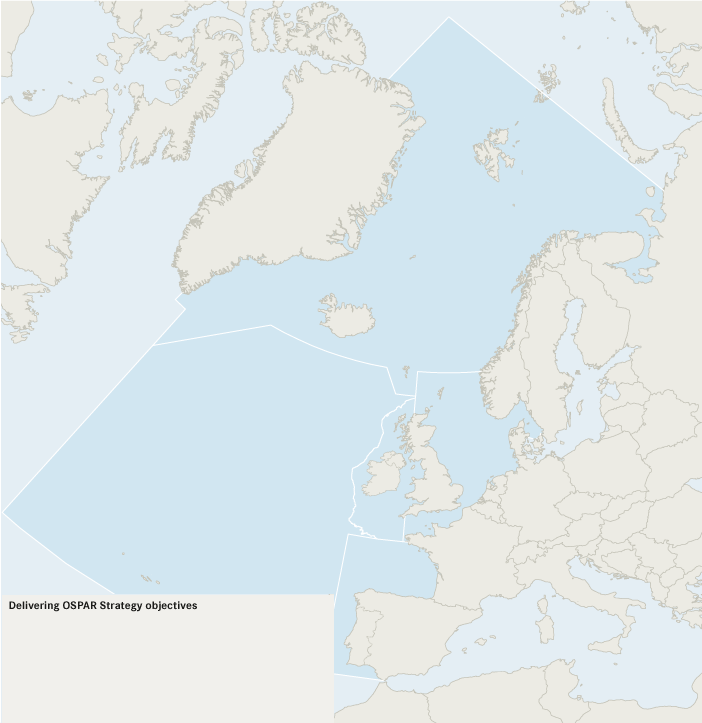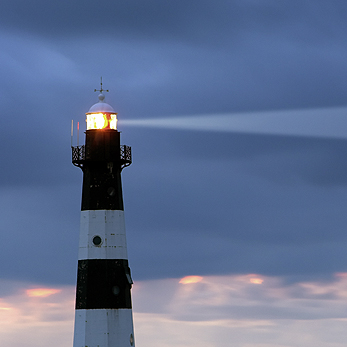Download12 Regional Summaries
OSPAR’s actions are clearly helping to reduce pollution of the marine environment, but many problems persist. The most widespread impacts on ecosystems result from fishing, and the emerging impacts of climate change cause serious concern. While a number of cross-cutting issues affect the quality status of large parts of the OSPAR area, the current status in relation to the OSPAR Strategy objectives and other specific imapcts of human activities is different for each Region.


There are no eutrophication problems. Nutrient inputs from coastal fish farming and atmospheric deposition are expected to increase.
Metal concentrations are mostly acceptable, but concentrations of PAHs and PCBs are unacceptable at around a third of monitoring sites. Pressure from oil and gas extraction, shipping and long-range atmospheric transport of contaminants is expected to increase.
There are no nuclear installations in OSPAR countries draining into the Region. Radioactivity is discharged by the offshore oil and gas industry, but trends in discharges have not been assessed. The outlook for overall pressure is uncertain.
Pollution with oil and chemicals from produced water, incidental spills and drill cuttings have reduced, but some pollution still continues. Offshore oil and gas activities and associated pressure are expected to increase.
Many species and habitats are threatened or in decline. Pressure from climate change and the related expansion of human activities into ice-freed areas is expected to increase.
Some fish stocks are beyond safe biological limits and fishing continues to have impacts on some seabed habitats. Fishing pressure has been reduced as a result of improved fisheries management and this is expected to continue.
Current status in relation to underwater noise is unknown. Increasing pressure from noise can be expected with an expansion in the range and intensity of human activities.
Current status in relation to marine litter is unknown. The outlook for pressure from litter is uncertain.
Current status in relation to non-indigenous species is unknown, although several problematic species have been identified. Increasing pressure from non-indigenous species can be expected as the range of human activities expands and as a result of climate change.
Many areas of the continental coast, including the Channel, Skagerrak and Kattegat, and UK estuaries show eutrophication problems. Overall pressure from agriculture, sewage effluents and atmospheric deposition is not expected to change.
Concentrations of metals, PAHs and PCBs are unacceptable at many, mostly coastal monitoring sites. The outlook for the overall pressure from land-based and sea-based sources and atmospheric deposition is uncertain.
Discharges of radioactivity from the nuclear industry have been reduced, but some discharges from this industry and from the offshore oil and gas industry continue. The outlook for overall pressure is uncertain.
Pollution with oil and chemicals from produced water, incidental spills and drill cuttings has reduced, but some pollution still continues. Oil and gas production and associated pressure are expected to decrease in the North Sea.
Many species and habitats are threatened or in decline. Fishing pressure is expected to reduce as improved management is introduced, but an increase in pressure from human activities is expected in the coastal zone.
Several fish stocks are beyond safe biological limits and the status of others cannot be fully assessed. Habitat destruction and the depletion of key predator and prey species are of concern. Fishing pressure is expected to reduce as improved management is introduced.
Current status in relation to underwater noise is unknown. Increasing pressure can be expected with an expansion in the range and intensity of human activities.
Amounts of marine litter are a concern. The outlook for pressure from litter is uncertain given the varied sources, their different trends and regulatory control.
Current status in relation to non-indigenous species is unknown, although several problematic species have been identified. Outlook for pressure is uncertain as measures on ballast water take effect, while climate change favours the spread of species to new areas.
Many estuaries and enclosed bays have eutrophication problems, but the total spatial extent of the area affected is small. Overall pressure from agriculture, sewage effluents and atmospheric deposition is not expected to change.
Concentrations of metals, PAHs and PCBs are unacceptable at some, mostly coastal monitoring sites, especially in the Irish Sea. The outlook for the overall pressure from land-based and sea-based sources and atmospheric deposition is uncertain.
Discharges of radioactivity from the nuclear industry have been reduced, but some discharges from this industry and from the offshore oil and gas industry continue. The outlook for overall pressure is uncertain.
There is only minor offshore oil and gas production. Pollution with oil and chemicals from these activities has reduced, but some pollution still continues. Pressure from offshore activities is not expected to change.
Many species and habitats are threatened or in decline. Fishing pressure is expected to reduce as improved management is introduced, but an increase in pressure is expected from human activities in the coastal zone.
Several fish stocks are beyond safe biological limits and the status of others cannot be fully assessed. Habitat destruction and the depletion of key predator and prey species are of concern. Fishing pressure is expected to reduce as improved management is introduced.
Current status in relation to underwater noise is unknown. Increasing pressure can be expected with an expansion in the range and intensity of human activities.
Amounts of marine litter are a concern. The outlook for pressure from litter is uncertain given the varied sources, their different trends and regulatory control.
Current status in relation to non-indigenous species is unknown, although several problematic species have been identified. Outlook for pressure is uncertain as measures on ballast water take effect, while climate change favours the spread of species to new areas.
Coastal and estuarine areas on the French coast are affected by eutrophication. Some estuaries in Portugal and Spain are potential problem areas. Overall pressure from agriculture, sewage effluents and atmospheric deposition is not expected to change.
Concentrations of metals, PAHs and PCBs are unacceptable at some, mostly coastal monitoring sites. The outlook for the overall pressure from land-based and sea-based sources and atmospheric deposition is uncertain.
Discharges of radioactivity from the nuclear industry have been reduced, but some discharges continue. There are no discharges from the offshore oil and gas industry. The outlook for overall pressure is uncertain.
There is one gas installation, which is not discharging to the sea. Pressure from offshore activities is not expected to change.
Many species and habitats are threatened or in decline. Fishing pressure is expected to reduce as improved management is introduced, but an increase in pressure is expected from human activities in the coastal zone.
Several fish stocks are beyond safe biological limits and the status of others cannot be fully assessed. Habitat destruction and the depletion of key predator and prey species are of concern. Fishing pressure is expected to reduce as improved management is introduced.
Current status in relation to underwater noise is unknown. The outlook for pressure from noise is uncertain given the varied sources, their different trends and regulatory control.
Amounts of marine litter are a concern, although they are lower than in Regions II and III. The outlook for pressure from litter is uncertain given the varied sources, their different trends and regulatory control.
Current status in relation to non-indigenous species is unknown, although several problematic species have been identified. Outlook for pressure is uncertain as measures on ballast water take effect, while climate change favours the spread of species to new areas.
There are no eutrophication problems. Atmospheric inputs of nitrogen from ship traffic are expected to increase.
No monitoring data have been reported on contaminant concentrations in the environment and status has not been assessed. The outlook for overall pressure from atmospheric deposition and from any development of offshore activities is uncertain.
There are no nuclear plants and, to date, no oil and gas installations discharging into the Region. The outlook for expansion of the oil and gas industry into Region V, and the development of associated pressure, is currently uncertain.
There is exploration for oil and gas but as yet no production. The outlook for oil and gas production in the Region is uncertain and will depend on factors such as technical and economic feasibility.
Many species and habitats are threatened or in decline. The outlook for pressure is uncertain.
Some long-lived and slow-growing fish species have been affected by fishing pressure. The destruction of vulnerable deep seabed habitats is a concern. The outlook for fishing pressure is uncertain.
Current status in relation to underwater noise is unknown. The outlook for pressure from noise is uncertain.
Current status in relation to marine litter is unknown. The outlook for pressure from litter is uncertain given the varied sources, their different trends and regulatory control.
Current status and outlook in relation to non-indigenous species is uncertain.

